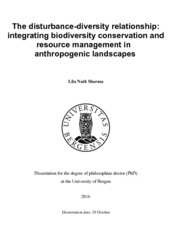| dc.contributor.author | Sharma, Lila Nath | |
| dc.date.accessioned | 2017-08-02T08:29:06Z | |
| dc.date.available | 2017-08-02T08:29:06Z | |
| dc.date.issued | 2016-10-28 | |
| dc.identifier.isbn | 978-82-308-3228-8 | |
| dc.identifier.uri | https://hdl.handle.net/1956/16172 | |
| dc.description.abstract | Disturbance, natural or anthropogenic, is ubiquitous to forest and grassland ecosystems across the globe. Many of these ecosystems have evolved alongside centuries old anthropogenic disturbance regimes. Understanding how disturbance impacts biodiversity and ecosystem service delivery is a topic of paramount importance as high biodiversity is likely to provide a wide array of ecosystem goods and services to an ever-growing human population. There is a general consensus that disturbance is an integral part of ecosystems and plays a role in shaping their diversity and function. It has been theorized that a certain threshold of disturbance plays a positive role in maintaining ecosystem diversity and health. However, the relationship between disturbance and diversity is contested on theoretical as well empirical grounds. The disturbance-diversity relationship is not as simple as theorized and appears somewhat elusive given the fact that impacts of disturbance are contingent on the attributes of the disturbance itself as well on the ecosystems exposed to disturbance. Empirical studies assessing impacts of disturbance, mainly anthropogenic, on diversity also do not show a general pattern; rather impacts can be considered as either positive or negative. In this context, this thesis synthesizes findings of four case studies dealing with impacts of human disturbance on floral diversity and composition at a local scale in specific ecosystems, with the aim of giving a perspective on how anthropogenic disturbance can be integrated at a landscape or regional level to manage resources at the intersection of societal and ecological concerns in a complex and dynamic socioecological system. This thesis is anchored on four individual case studies from forests, grasslands and farmlands located at different elevations, ranging from tropical to subalpine climate, on the southern slopes and foot plains of the Himalaya in central Nepal. The study area comprises varying levels of anthropogenic disturbance from relatively little disturbed park area to visibly modified agroforests, and from government managed to privately owned resources. The main analyses include (i) a comparison of sites with different levels of disturbance and land-use to assess how natural and anthropogenic disturbance impacts floristic composition and richness (Paper I and II), (ii) a comparison of timegap vegetation data to assess the impacts of reduced disturbance (Paper III), and (iii) an analysis of vegetation and land-use change based on oral history and transect observations (Paper IV). A combination of quantitative and qualitative tools from vegetation and social sciences was used to collect and analyse the data. Vegetation data, mainly presence/absence and abundance of vascular plants collected in quadrats, are the main data for all study sites. This synthesis demonstrates that anthropogenic disturbance and changes to it can have profound impacts on floral richness and composition, and these impacts are contingent to the type and intensity of disturbance and ecosystems exposed to these disturbances. It is found that canopy gap disturbance is important in subtropical and temperate forests as it promotes tree regeneration and species diversity. However, higher richness in gaps of intermediate size was not confirmed in the subtropical forest. It is demonstrated that a decline in anthropogenic disturbance – fire and grazing – in grasslands as a consequence of land abandonment allowed encroachment of shrubs and trees into the grasslands with a subsequent loss of grassland-dependent flora until the grasslands are eventually converted into closed-canopy forests. Cessation of anthropogenic disturbance in forest, mainly lopping and felling of trees for firewood and fodder, led to increased forest canopy and a decline in floral richness over a short time span of two decades. Changes in richness across the life-forms were not consistent with the overall decline: whereas herbaceous flora declined substantially, woody flora increased. In an agricultural landscape, farmlands were consistently richer than nearby naturally regenerated secondary forests in terms of tree species richness at different scales. Retention and planting of a variety of tree species in the farmlands in response to a shortage of forest resources and new conservation policies is a likely explanation for the higher richness found on farms. This thesis demonstrates that anthropogenic disturbances associated with low intensity land-use practices of subsistence farming system help maintain floral richness and composition in human-modified landscapes at a local scale, which in turn contributes to the biodiversity and ecosystem services at a landscape and regional level. Alteration of the traditional practices of management/disturbance can have notable consequences not only for species richness but also for landscape patterns and processes. Mimicking near-natural disturbance in forests and pastures and considering human disturbance as an integral ecosystem process contributes to maintain biodiversity and ecosystem function, and can be regarded as an amicable strategy to produce food with a minimal ecological footprint in landscapes where human disturbance is inevitable due to people’s dependency on local natural resources. | en_US |
| dc.language.iso | eng | eng |
| dc.publisher | The University of Bergen | eng |
| dc.relation.haspart | Paper I: Sharma LN, Grytnes JA, Måren IE,Vetaas OR (2016) Do composition and richness of woody plants vary between gaps and closed canopy patches in subtropical forests? J. Veg Sci 27:1129–1139. The article is available at: <a href="http://hdl.handle.net/1956/16171" target="blank"> http://hdl.handle.net/1956/16171</a> | eng |
| dc.relation.haspart | Paper II: Sharma LN, Vetaas OR (2015) Does agroforestry conserve trees? A comparison of tree species diversity between farmland and forest in mid-hills of central Himalaya. Biodivers Conserv 24:2047–2061. The article is not available in BORA due to publisher restrictions. The published version is available at: <a href="https://doi.org/10.1007/s10531-015-0927-3" target="blank">https://doi.org/10.1007/s10531-015-0927-3</a> | eng |
| dc.relation.haspart | Paper III: Sharma LN, Vetaas OR (2016) Decline in anthropogenic disturbance in Himalayan montane forests have negative impacts in floral richness. The article is not available in BORA. | eng |
| dc.relation.haspart | Paper IV: Sharma LN, Vetaas OR, Chaudhary RP, Måren IE (2014) Pastoral abandonment, shrub proliferation and landscape changes: A case study from Gorkha, Nepal, Landsc Res, 39:1, 53-69. The article is not available in BORA due to publisher restrictions. The published version is available at: <a href=" http://dx.doi.org/10.1080/01426397.2013.773299" target="blank"> http://dx.doi.org/10.1080/01426397.2013.773299</a> | eng |
| dc.title | The disturbance-diversity relationship: integrating biodiversity conservation and resource management in anthropogenic landscapes | eng |
| dc.type | Doctoral thesis | en_US |
| dc.rights.holder | Copyright the author. All rights reserved. | en_US |
| dc.identifier.cristin | 1450105 | |

